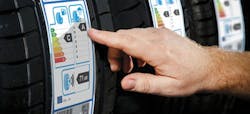It has been almost three-and-a-half years since tire labeling legislation was introduced across Europe. Although tire labeling is now completely accepted “as part of the industry” in all European countries, the procedure is far from perfect and open to criticism.
The chief area of discontentment with the legislation has always been and continues to be that tire labeling is completely open to abuse and fraud due to the absence of any official and effective control from a third party not connected with the industry. Therefore tire manufacturers are left to evaluate their own products, and the potential for bias is hardly reassuring.
Fortunately it has just been announced that this “freedom loophole” is about to be slammed shut. The launch of the Surveillance Action on Tyres 2015 project (MSTYR15), which was introduced on April 6 of this year, will give accountability to tire labelling. The project will be funded by the European Commission’s Horizon 2020 program and coordinated by the Product Safety Forum of Europe (PROSAFE).
This most welcome development will take place over the next two years until February 2018. As part of the project, qualified inspectors from 13 European Union countries and Turkey will actively test the rolling resistance and wet grip performance of close to 150 different tire brands, with the aim of comparing each tire’s actual characteristics with its displayed EU tire label rating.
When I spoke with a representative of MSTYR15, I was informed that the project’s primary objective was to establish the adoption of “best practices,” along with an even higher level of approach to market surveillance toward all tire suppliers for the benefit of end users.
At the same time MSTYR15 makes it clear that action will be taken when incorrect labels are found to be in use, which could lead to incorrectly labeled tires removed from the market sector.
PROSAFE states that the labeling inspection project covers summer passenger tires that are subject to regulations EC1222/2009, EU228/2011 and EU1235/2011. Appointed inspectors from Belgium, Bulgaria, Croatia, Estonia, Finland, Germany, Latvia, Lithuania, Luxembourg, Poland, Romania, Spain, Sweden and Turkey will collectively coordinate random inspections and be armed with special mobile devices that can effectively access a continually updated database of European results.
This latest move to regulate the standard of tire labels being presented to the European tire market sector has been enthusiastically welcomed by many relevant associations. That includes members of the European Tyre & Rubber Manufacturers Association (ETRMA), who have stated they believe this action will have a good effect toward establishing a level playing field across Europe in terms of the tire labels on tires for sale.
Although the news of this ground-breaking development has only just been revealed, it looks set to radically re-set and tighten up the standard of tire labeling — and hopefully eradicate any companies that up until now have been less than economical with the truth about label ratings.
As with all new developments in any form of legislation, it will take time for the European tire market to fully appreciate the effectiveness of the checks, but I firmly believe that it at least will be the beginning of an age when all tire labels in Europe will be accurate. Only time will tell how long this process will take; I will be keeping a close watch on the situation. ■
John Stone has been working within the global tire industry for the past 24 years. In 2004 he launched his own consulting company, Sapphire Media Services. Stone also writes for tire and automotive-related publications in Europe, South Africa and Asia.
To read more European Notebook columns, click:
From a Rubber Pattern to Total Control! Future Tires Will be a Source of Invaluable Information
An Endless Battle for Legal Tires in Europe
European and American Wheel Alignment Markets Work Almost in Unison



